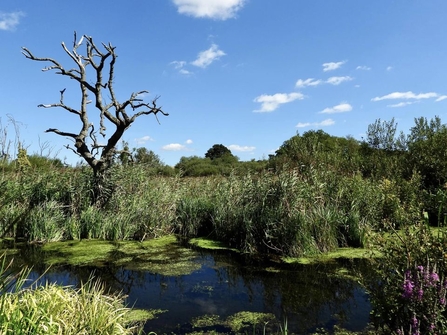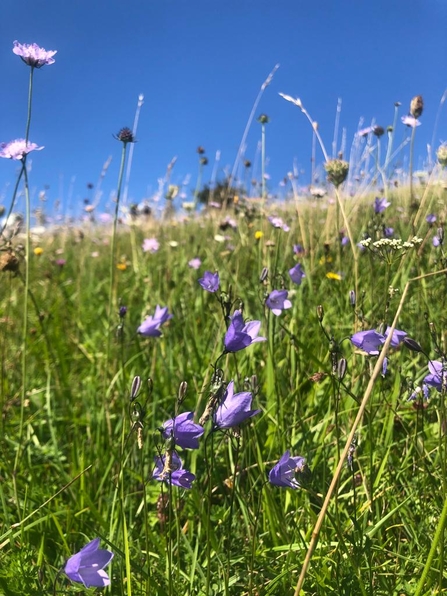On a proper sunny August day, Ian Rickards took some of the hard-working Ashford volunteer team to visit two very different Kent Wildlife Trust reserves in the East of Kent: Ham Fen, the last surviving ancient fen in Kent, just west of Sandwich and Coombe Down in Dover.
At Ham Fen, long-time volunteer cattle-checker Roland (works at Pegwell Bay on Wednesdays, goes fishing on Thursdays) gently moved the glossy black Aberdeen Angus cattle and three water buffalo on as we took the marshy path through tall swathes of wild flowers to the fen. This is where the beavers have, for the last 22 years, been re-engineering this landscape of deep peat and running water. They slow the water flow, build dams to raise the water level and create deep pools around their lodges, making other pools and marshes in the process. The dams are built of logs they fell and drag to the dam site, packing it solid with mud. If they hear water trickling, they block it with new wood or scoops of mud. The beavers’ lodge, also built of branches, bark and mud, is now several metres in diameter and height and barely visible, topped with hemp agrimony, reeds and giant hogweed. The lodge entrance is underwater, with sticks of willow stuck in the bed outside the lodge so they can access fresh food if the surface freezes in winter. The beaver pool is quiet and secluded, a favourite spot for the kingfisher, surrounded by head-high flowers tangled with hops and the hawthorns that the beaver seem to leave alone. Mature oaks standing in water have died, providing safe perches for the turtle doves who now breed here. Beaver are nocturnal and dislike the hot sun so we saw none. There is no public access, but the evening safaris run by Kent Wildlife Trust are the best way of getting a glimpse of these reclusive animals.
Kent Wildlife Trust were the first to re-introduce European beaver into a contained reserve in this country and the initial three kits and a pair have thrived and bred. Beavers can now be observed on the River Stour, including from the Sainsbury’s car park in Canterbury, and at Conningbrook Lakes in Ashford where pointed-pencil stumps left by their tree felling are very evident.


